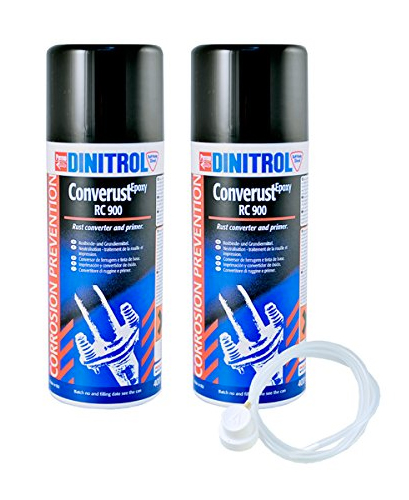23rd Oct 2017
One of the key differences between a rust converter versus rust remover
The key difference between a rust converter and a rust remover is that one causes rust to separate away from the metal surface while the other converts rust to a stable compound. Knowing the difference between a rust converter and a rust remover and how each product works will help know how and when - or if at all - to apply them.
Many car enthusiasts will argue that rust converters don't work because they don't prevent rust. A rust converter is not designed to rust proof but rather the inert compound formed once rust is converted forms a barrier layer to corrosion. For any ageing car, regularly applying rust proofing will protect from corrosion. There may, however be vulnerable areas to the wheel wells, undercarriage, area around the windscreen or bumper where rust could appear. These medium areas of iron oxide formation are where rust converters are best indicated.
How effective is a rust converter? Very effective if you choose a rust converter that penetrates deep into the rust and you prepare the metal surface as per the product guidelines.
So lets discuss these two products and their mode of action.
How a rust converter kills iron oxide
A rust converter takes the iron oxide (rust) and converts it into a ferric phosphate. Minimal s urface preparation is required prior to application. The resulting inert compound which is produced offers some protection from further corrosion.
urface preparation is required prior to application. The resulting inert compound which is produced offers some protection from further corrosion.
Rust converters are a water-based chemical solution which contains two main active ingredients. These differ between products available commercially containing either phosphoric acid or tannic acid, or a combination of both. The other ingredient added is an organic polymer, which serves to provide a protective primer layer to the substrate it is applied to. Phosphoric acid converts iron oxide (rust) into an inert layer of iron phosphate, which is black in colour. This inert layer then acts as a barrier layer or protective coating.
A rust converter eliminates the need to sandblast rust therefore less time and energy is involved in the process. These products can be used for a wide range of applications: vehicles, trailers, industrial equipment and machinery, farming equipment and domestic outdoor fittings and fixtures.
Prior to application remove flacking rust with a wire brush (rather than sealing it in), clean and degrease the area so that any contaminants present don't interfere with the conversion of iron oxide.
Applied to the undercarriage of a vehicle, it is good practise to then follow this process with applying an underbody wax for long-term rust prevention.
The key benefit of Dinitrol RC 900 rust converter is that it penetrates rust 7 to 10 times deeper than standard rust converters. RC900 contains a complex organic chelat base and epoxy resin to actively convert the rust and is free of lead, zinc and chromium.
What is a rust remover?
There is no chemical process involved. Instead a rust remover is applied to the affected area to help in the process to banish rust. Rust removal products contain oxalic acid as the main ingredient. Sanding away as much of the rust as possible is advisable before the rust remover is applied. Surface preparation is key and a rust remover is applied to be absolutely sure that all traces of rust are removed before applying a rust proofing underbody or cavity wax.
The purpose of these products is to help speed up the process of removing rust from a metal surface. The oxalic acid reacts with iron oxide (rust) causing it to separate away from the metal surface. Once the rust has disappeared you are left with a stable surface for priming and painting. 
I hope we have offered a satisfactory answer to explain the difference between these two products so you know which to use before applying an under coating or cavity wax rust proofing.
Removing all traces of rust really is the closest to a permanent solution. A phosphoric acid based rust converter kills and prevents rust from reforming, but its not the complete solution. Application of rust proofing is necessary too.
